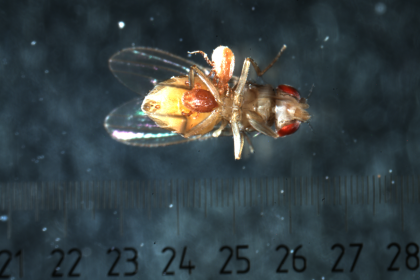Where mite flies lay eggs? Environment mediated parasite avoidance during Drosophila ovipositing.
The latest Paper of the Month for Parasitology is Where mite flies lay eggs? Environment mediated parasite avoidance during Drosophila ovipositing.
by Collin J. Horn, Monika K. Mierzejewski, and Lien T. Luong
The ecology of fear describes the negative impacts predators have on potential prey even when those prey are not directly attacked. The stress of being exposed to predators and the effort of avoiding predation can negatively impact the growth, longevity, and ultimately fitness of potential prey. Analogously, avoiding parasites can negatively impact potential hosts even when they do not become infected. In our study we tested if flies (Drosophila nigrospiracula) avoid ovipositing (laying eggs) near ectoparasitic mites (Macrocheles subbadius). Because environments can vary greatly in numbers of parasites and overall quality (e.g. different food availability), we also tested if the quality of potential oviposition site impacts parasite avoidance behaviors. Since mite infection and exposure (sans infection) strongly impact hosts, we hypothesized that all else being equal flies would avoid ovipositing near mites. Furthermore, we predicted that flies would avoid ovipositing near mites even if it required giving up access to otherwise superior sites.
First we tested if flies avoided mites when the sites were otherwise identical. We created arenas containing two dishes of the same media (cactus, instant potato, Drosophila media, and yeast), but only one dish had a mesh sealed chamber containing mites. Five female flies and three males were given 48 hours to mate and lay eggs in the arena. Results show females laid 86% of their eggs at the mite-free site. So when all else was identical, flies avoided ovipositing near mites.

In order to test if environmental conditions affect mite avoidance, we confirmed that flies prefer ovipositing at sites with nutritional cactus and at sites seeded with eggs from conspecific flies. Flies laid 84% of their eggs at sites containing cactus over sites without cactus and 63% at sites pre-seeded with other eggs over unseeded sites. Then we asked if the risk of infection eliminates these preferences. Flies preferred infested sites with cactus over mite-free sites that did not have cactus (78%). Likewise flies preferred infested sites seeded with eggs over unseeded sites that were mite-free (65%). Contrary to our initial prediction, preferences for specific environmental factors, i.e. other eggs and nutritional cactus, overpowered avoidance of mites.
Potential hosts face a complex landscape of fear where avoiding parasites can come at a cost. Flies tolerated mite presence, and hence risk of infection, in order to access better oviposition sites. Our results suggest that environmental heterogeneity may limit the avoidance of parasites by at risk hosts and ultimately “trap” hosts in infectious environments. We suggest that exploring the non-consumptive effects of parasites on host populations is an interesting future direction in parasite research and in the ecology of fear.
The full article is freely available to read and download until 28, October, 2019.







Thanks alot!